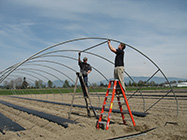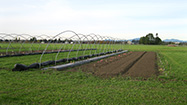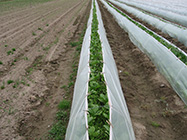Most tunnels are passively, solar-heated, using no electricity. High Tunnels are usually high enough to drive a tractor through. Crops are grown in the ground, usually with drip irrigation.

High Tunnels
See our Glossary for definitions of terms.
A temporary agricultural structure with arched or hoop-shaped frames covered with one or more layers of clear plastic. Tunnels are high enough to drive a tractor through. Crops are grown in the ground, usually with drip irrigation. Most high tunnels are solar heated, using no electricity. They can be easily covered and uncovered, and easily assembled and disassembled in order to move to a different field site. High tunnels have a big impact on season crop extension. Also commonly referred to as a hoop house.
Tunnels or hoophouses, are temporary agricultural structures with arched or hoop frames, and are covered with clear plastic. They can be easily covered and uncovered, and assembled and disassembled in order to move to a different field site.
Most tunnels are passively, solar-heated, using no electricity. High Tunnels are usually high enough to drive a tractor through. Crops are grown in the ground, usually with drip irrigation.

Structures
ATTRA Hoophouse Webinar. A slide presentation that presents the uses and benefits of hoop houses, different types of hoop houses, construction, materials and cost estimates, management of crops, soil fertility, pests and weeds, and the economics and marketing of crops.
Building a Hoophouse (Part 1) and Building a Hoophouse (Part 2). Michigan State University’s Hoophouse expert, Adam Montri, narrates this two-part instructional video on hoophouse construction.
Field Hoophouse. An easy-to-make field hoophouse. New Mexico State University Circular 606.
High Tunnel Overview. Benefits and costs of high tunnels. Links to research studies regarding crop production. The Pennsylvania State University.

High Tunnel Production and Low Cost Tunnel Construction Webinar from eOrganic. A Webinar presented by Tim Coolong, University of Kentucky, is an introduction to season extension using high tunnels. Covers common issues associated with tunnel production, and provides a short overview of how to construct a low cost pvc tunnel. The Webinar is for growers who are interested in season extension, but who may not want to invest a large amount of money right away.
High Tunnel Construction. Site selection and a slide show of high tunnel construction. Rutgers University.
High Tunnel Guide. Brief overview of advantages, disadvantages, structure selection, installation and management of high tunnels. USDA NRCS.
High Tunnel Manual. Construction and management information, case studies of farms in US using high tunnels with different crops and management intensity. Cornell University, University of Vermont, NESARE.
How to Build a Low-Cost Hoop House. Kerr Center for Sustainable Agriculture.
Manufacturers and Suppliers. List of common manufacturers and suppliers of high tunnels in the U.S.
Portable Field Hoophouse. A simple, inexpensive design for a portable field hoophouse. Washington State University Extension Bulletin EM015.
The Hoophouse Handbook. Provides grower-based experiences using hoophouses and high tunnels for vegetable and flower production. Includes design ideas, budget sheets and much more. Growing for Market.
Wind Issues
Wind is perhaps the biggest challenge to high tunnels. The following are links providing information on how to prevent damage; some presentations show outcomes of damage.
- Hurricane Preparedness for Producers of Horticultural Crops. Chatham County Center, North Carolina Cooperative Extension – scroll down to “Greenhouse Protection” for tips on preventing damage during high winds.
- Iowa State University. see slides 16 and 21 (2007 and 2008)
- Kansas State University by Ted Carey (2004)
- Washington State University. (2010)
Growing Crops
Early Maturity. How hoophouses promote early maturity in tomato plants. Nobel Foundation
Crops for High Tunnels. Studies and resources of warm season vegetables and melons, cut flowers and small fruit grown with high tunnels. Hightunnels.org.
Hoophouses on the Farm. Small fruit and vegetable crops production, mistakes learned, and profits gained. Mielke Farm, Wisconsin.
Iowa High Tunnel Fruit and Vegetable Production Manual. A manual including worksheets to provide growers with the information and resources to use high tunnels effectively, enhance productivity and net income, and learn from the experience of other high tunnel users. D. Huntrods, ed., Iowa State Cooperative Extension (2010).
Significant Increases. Crops with greatest success due to plastic mulch. North Carolina State University.
Strawberry Production with Mulch. Research study to investigate effect of black and red plastic mulch on strawberry production. Crop Science Journal.
Tomato Production under High Tunnels
General Production Techniques
Four Seasons Harvest. Provides information on seasonal crop production with the help of hoophouses. Eliot Coleman, Four Season Farm.
Growing More Out of Your Season. An informative introductory power point on season extension. Includes many types of plasticulture, advice from growers, as well as a budgeting guide to help decide if platiculture is an economical choice. University of Tennessee Extension.
High Tunnel Crop Production Project. Overview of high tunnels, including temperature modification. Mississippi State University.
High Tunnel Discussion Group. A USDA-sponsored project to test and promote high tunnel systems in the Central Great Plains. Provides information and links to relevant sites around the world, so that growers and educators have a one-stop source where they can find information on all aspects of high tunnel construction and use.
High Tunnel Production Manual. Although written for farmers in Minnesota this comprehensive guide is applicable to high tunnels everywhere. Includes suggestions for construction, fertigation, disease management, economics, and more.
History and Trials. The history of high tunnels and the influence of mulch on tomato and lettuce yields. Kerr Center for Sustainable Agriculture.
Season Extension Techniques. Season extension can enable year-round crop production as well as higher-quality produce. This publication describes season extension techniques and provides sources for equipment, supplies, and further information. ATTRA.
Season Extension. Advantages and disadvantages of using plasticulture to extend the crop growing season. North Carolina State University Extension.
Season Extension Tools and Techniques. Summary of various season extension techniques including plasticulture plus many links for further research. University of Kentucky Extension.
Medium Tunnels
A Pictorial Guide to Preparing and Installing Gothic-framed, Outdoor Winter-ready Mid-Tunnels. Step by step instructions and photos. Ohio State University Extension.

Low Tunnels
See our Glossary for definitions of terms.
Low tunnels are made by placing plastic or fabric row covers over wire or plastic hoops and securing with clips, to lengthen the growing season for the crop and improve overall crop health and quality. Vent holes or slits allow for adequate air circulation and ventilation during warm temperatures. Low tunnels usually have a peak height of 18” to 36” from the soil surface. Sometimes called a cloche.
Low Tunnel Benefits and Types. The benefits of using low tunnels and common types of covers. New Mexico State University Extension.
Low Tunnel Basics. Basic low tunnel construction information. The Pennsylvania State University.
Low Tunnel Ventilation. Introduces the importance of monitoring temperatures in low tunnels and describes several ventilation techniques. University of Kentucky Extension.